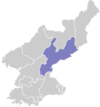Changjin County
This article needs additional citations for verification. (June 2009) |
Changjin County
장진군 | |
|---|---|
| Korean transcription(s) | |
| • Hanja | 長津郡 |
| • McCune-Reischauer | Changjin kun |
| • Revised Romanization | Jangjin-gun |
 | |
| Country | North Korea |
| Province | South Hamgyong Province |
| Administrative divisions | 1 ŭp, 3 workers' districts, 16 ri |
Changjin County is a mountainous county in South Hamgyŏng province, North Korea.
Geography
Changjin lies on the Rangrim and Pujŏllyong ranges, and most of the county sits atop the Kaema Plateau. Due to this location, Changjin has a particularly cold climate. The highest point is Ryŏnhwasan (련화산). The chief stream is the Changjin River. Lake Changjin is a large reservoir in Changjin County.
Administrative divisions
Changjin County is divided into 1 ŭp (town), 3 rodongjagu (workers' districts) and 16 ri (villages):
|
|
History
In historical contexts the lake is sometimes known according to its Japanese pronunciation, as the Chosin Reservoir.[1] In 1950 it was the site of a major battle of the Korean War, the Battle of Chosin Reservoir, in which the Chinese People's Volunteer Army stopped the northward advance of the United Nations allied forces, but paid a heavy price in casualties.
Economy
Changjin produces large amounts of lumber, and leads the province in mine production. Deposits of silver, graphite, jade, and gold are found in the area. Local agriculture is dominated by livestock raising and dry-field farming; local crops include potatoes, barley, soybeans, red beans, maize, and oats.
Transportation
Although it could long be reached only by horse or automobile, the construction of a power plant on the Changjin River also brought the Changjin Line of the Korean State Railway to the county. Water transportation also developed thanks to the power station.
See also
References
- ^ Roy E. Appleman (1992) [1961]. "Chapter XXXVIII The X Corps Advances to the Yalu". South to the Naktong, North to the Yalu. United States Army in the Korean War. United States Army Center of Military History. Retrieved 2006-11-07.
{{cite book}}: External link in|chapterurl=|chapterurl=ignored (|chapter-url=suggested) (help)
External links
- In Korean language online encyclopedias:

